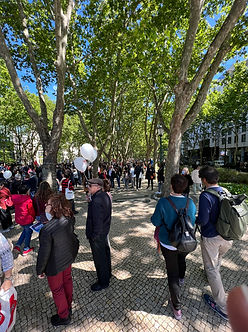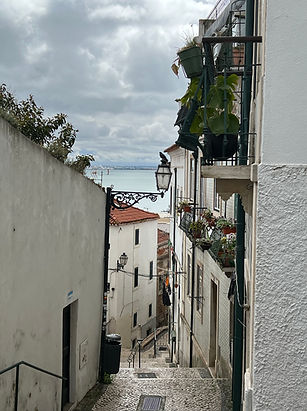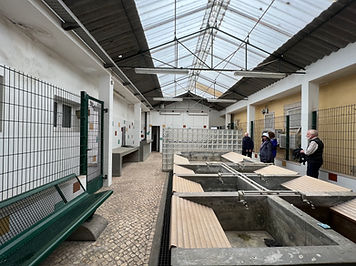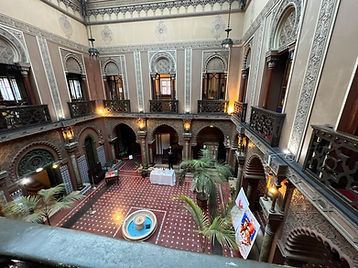
Lisbon
Day 1: April 25
It was April 25 and we’d arrived. The sun was out, the sky a brilliant blue, and the streets were a frenzy of activity! Droves of people, lively music, red flags and red carnations everywhere. We were being dropped off at our tour hotel by a chatty, friendly taxi driver after our overnight flight from Chicago, our plane change in Amsterdam, and our early afternoon landing in Lisbon. The welcome meeting of our Heart of Portugal tour was in just four hours.
Reading up on Lisbon at home, I’d seen photos of the suspension bridge connecting the city to the municipality of Almada on the other bank of the Tagus River. Reminiscent of San Francisco’s Golden Gate Bridge, it is called the 25 de Abril Bridge. Intrigued that we’d be arriving in Lisbon on an obviously important day, I had looked it up and had learned that April 25 is a national holiday, Freedom Day, the anniversary of the 1974 peaceful military coup that brought down the regime of António Salazar, ending more than 40 years of dictatorship in Portugal.
Throughout Portugal, Freedom Day is celebrated with parades, fireworks and other revelry. And copious amounts of red carnations. Hardly any shots were fired during the 1974 revolution, so when overjoyed citizens handed out red carnations to celebrate the overthrow of their government, the soldiers symbolically placed them in the barrels of their guns. Freedom Day celebrates what’s become known as the Carnation Revolution.
Our cab driver seemed excited for us, that we were arriving on such a grand day and that our hotel was so well situated to take it all in. The Hotel Lisboa Plaza was less than a half block off the Avenida de Liberdade, or Avenue of Liberty, the wide, tree-lined boulevard where all this festivity was taking place!
We checked into the hotel and went up to our room for quick showers and a change of clothing. There wasn't even the slightest temptation to lay down and take a rest. We've discovered that the fastest way to get over jet lag is to stay awake, pretend we haven't missed a night of sleep, and power through! We headed back outside to catch the end of the parade and do some strolling and people-watching.



After a couple hours of checking out the neighborhood, we went back to the hotel. We were excited that it was time to meet up with our tour leader, Claúdia Costa, and our 26 tour colleagues!
Rick Steves Europe suggests that tour members arrive in Europe at least a day or two in advance of their tour, so that they’ve mostly gotten over jet lag by the time the tour starts. It’s excellent advice that we usually heed, using the pre-tour days to explore on our own in cities and towns that are nearby but not on the tour itinerary. This time, though, taking a tour that felt very "last minute" in comparison to others we've been on, and given that Covid was still interrupting travels for many, we kept things simple, affixing no independent travel days to either end of our tour.
A bad flight delay today could have really messed things up for us, and I don't usually take those risks. But it all worked out, and looking back on it now, our arrival on the first day of the tour had the advantage of releasing us from the need to figure out what to do to stay awake and try to make it to a somewhat normal bedtime. At the welcome meeting, there were new friends to meet! Snacks to nibble and Port to sip! We were each given a sheet with two entrée choices for each of the group dinners and needed to make our selections. Pick our tour buddies. Start to put faces to the names we already knew from the tour member roster we'd received at home. Claúdia was giving us a crash course on how to order coffee so it would be just the way we liked it, how to use the public transport card that she had given to each of us, and how to say hello, goodbye and (most importantly) thank you in Portuguese. (I found it interesting that the way you say thank you depends on your gender. A female says "obrigada." If you are male, it's "obrigado," with the final "o" pronounced "oo.")
When all the introductions and instructions were finished, we hit the streets for our first guided walking tour. On our prior Rick Steves tours, the first evening's walk had been intended mainly to orient us to the immediate area surrounding our hotel. But here in Lisbon, native Claúdia's own stomping grounds, she had more ambitious plans, and we were all in! It was the golden hour, a glorious time of day to be out and about. I loved boarding a bright yellow graffiti-covered trolley (the Elevador da Glória funicular) and climbing up a steep, steep street to get to the Bairro Alto neighborhood. Up there we had a stunning panoramic view of the red rooftops of Lisbon. Claúdia pointed out Castelo de São Jorge (St. George castle) perched high on a hill on the opposite side of the city and said that tomorrow we'd be up there, with our scenic view going this direction. So much urban beauty!
Here are some photos from that first evening in Lisboa, the group's first glimpses of the city.












Our first group dinner was at Cozinha da Eastção, a fun railway-themed restaurant near the historic Rossio train station building. We divided ourselves up among three large tables and enjoyed some traditional Portuguese cuisine, served family style. Back at the hotel, Gary and I should have just headed zombie-like upstairs and tumbled straight into bed. Not counting a couple short cat naps on our flights, we'd been awake for about 33 hours. However, we were pretty keyed up after this very busy, fun evening. A quiet nightcap in the hotel's bar seemed like a good way to wind down our day.
The four tour mates who'd beaten us to the bar had other ideas for us. They were seated around a table together, and when they saw us walk in they beckoned us to join them, scooching their chairs over to make room at the table for two more. Soon we were pulling over another table for two more couples who wandered in behind us. Gary and I spent the last hour of the day getting to better know these new friends and went upstairs super tired but so very happy! We knew already that this was going to be a great group and we were going to have a wonderful time traveling all over Portugal with them.
Day 2: April 26
Let's get this party started!
Our schedule for today was posted on an easel in the lobby of the hotel. It had been there since last evening. This was something we’d be able to count on throughout the tour: a nightly posting of the next day’s group activities, along with suggestions on what to do during our free time. So when we woke up this morning after a very solid night of deep sleep, we just had to consult the photo we’d snapped of that schedule to be reminded that we’d be meeting in the lobby at 8:45 today to start a half-day walking tour of Lisbon.
The Hotel Lisboa Plaza is a beautiful hotel, bigger and a bit more luxurious than the hotels we've occupied on prior RS tours. With a beautiful rooftop terrace and several spacious main floor common lounge areas, and our group being (we could already tell) so social, it was perfect for our stay. We assumed that there was a breakfast room intended for us, probably a small room with a buffet table on one wall, and we went in search of it. Instead, our breakfast was in the hotel's main dining room, a well-appointed space with multiple stations containing an amazing array of food. So many choices to fuel us up for all the walking we'd be doing this morning! The usual breakfast offerings were of course available, things like eggs, bacon, pancakes, hot and cold cereal, fresh fruit, yogurt, pastries, muffins, croissants. My favorite is always the crusty breads. Gary loves it that European breakfast buffets always include prosciutto and other thinly sliced meats and cheese. But here we could also choose grilled sardines and other smoked or pickled fish, and there were tureens with two different kinds of creamy soup, and even a chocolate fountain. I'd read that sardines are a big deal in Portugal. The Portuguese love them. Gary dove right into the sardines. I was a little more timid, but I did have a couple because, you know, when in Rome . . .



When we gathered in the lobby, Claúdia air-dropped to each of us the group photo she had taken at the start of last evening's walk. She had posed us in front of the war memorial statue on Avenida de Liberdade. Unbeknownst to us, as we'd gone around the room at our welcome meeting, introducing ourselves, Claúdia had been scribbling notes as to what each person was wearing. This permitted her to annotate the photo with everyone's name and she'd stayed up last night doing that, a thoughtful gesture that gave us a means of quickly learning each other's names.

Guided walking tour of Lisbon
Just like Rome, Lisbon is a city of seven hills. We started our tour in Baixa, the district where our hotel was located. It is the historic heart and commercial center of Lisbon, situated in a valley between two hilltop districts: the Bairro Alto, to the west, where we'd been last evening, and the Alfama, to the east, the other district we'd be exploring today. In Baixa, there was so much beauty looking down at the pavement that I had to keep reminding myself to look up! The pedestrian walkways and squares are stunningly paved in small blocks, limestone and basalt, laid in mosaic patterns. This is a traditional Portuguese art form called calçada.
After we left Baixa, we wound our way through the Alfama district, a maze of steeply inclined streets. There are staircases tucked everywhere. The profuse amount of graffiti gives the area a bohemian feel. This is not simply urban vandalism, spray painting gone amok. It is intentional art. The large, detailed, hand-painted murals add an explosion of life and color to the neighborhoods. Many tell a story based on a historic event, a cultural tradition, or a political issue. Some contain touches of humor. We enjoyed having Claúdia decode them for us.
On our walk today, Claúdia frequently paused to give us a tidbit of history, to comment on the architecture, monuments and street art we were seeing, to share a personal anecdote, to enlighten us as to some aspect of Lisbon's daily life and culture today, or just to answer our questions. The pleasant, leisurely pace made the hilly streets a breeze. One of the rewards at the top was the scenic overlook known as Miradouro ("viewpoint") das Portas do Sol.


















This old Alfama neighborhood is a tangle of closely spaced apartments and a public laundry/bath house where residents shower and wash their clothing. The large concrete laundry tubs have washboards attached. The walkways through this neighborhood are very narrow. Next to many of the apartment doors you see stone plaques etched with photographs of people. Claúdia explained that the people in the photos are the residents of these apartments, and that this was an important art project designed to say to tourists, "real people live here, please respect them."
Buddy-bonding over lunch
Claúdia ended our tour on a small street that had many wonderful restaurant choices for lunch on our own. Gary and I perked up at her comment on the excellent seafood at Maria Catita. Our tour buddies, Anne and Mark, accepted our invitation to join us at one of their outdoor tables. We love the "tour buddy" system. It's the way that attendance is quickly and efficiently taken on a Rick Steves tour. Instead of a time consuming headcount, the leader simply calls for a "buddy check," the cue for each person to look around and make sure his/her buddy is there. If no one sounds an alarm, we know we're good to go. But for us, the tour buddy system has always served as more than just a way to avoid a roll call. On this tour as on our prior two Rick Steves tours, our tour buddies became special friends. We knew that there was likely to be an upcoming "buddy intro" evening, and we wanted to be prepared to share some fun information about Anne and Mark with the rest of the group. This gave us license to ask more questions than you might usually ask when first meeting someone. It allowed us to quickly get to know them very well. Be aware that these buddy intros are coming and use it as an opportunity to make a good friend early in the tour even if you aren't normally an extrovert! We treasure our friendship with these energetic and fun-loving tour mates that started early and continued to build throughout the trip.

About Vinho Verde
Vinho Verde comes from the wine region by that name, located in northern Portugal. Neither Anne nor I had tried it yet so we each ordered a glass with lunch. Although the translation is "green wine," our Vinho Verde was a very pretty white. There are also red and rosé Vinho Verdes. It's "green" as in "young," i.e., it's un-aged. We both loved it. It's lightly effervescent, but not enough to be called "sparkling," a bit fruity but not overly sweet, just crisp and very refreshing. This would become my go-to white wine for the rest of our time in Portugal! When I get home from any trip to Europe, I find myself extending the travel experience by remaining snobbily loyal to that country's wine. So after a trip to Italy, I only drink Italian wine for the next few weeks, and the same with France and French wine. I didn't think I'd find Vinho Verde at home. My assumption was that it's not exported since it's meant to be released when it's "new" (3 to 6 months after the grapes are harvested) and consumed soon after bottling. My assumption was not true! I can buy it at home and enjoyed many a glass over the summer while sitting on my patio reminiscing about Portugal!
Say Yes to the Chef!
We had a delicious meal at Maria Catita, superb in quality, with friendly, attentive service. We all opted to order from the day's fixed price menu, handwritten on a chalk board. We could choose one of two main courses. This day it was stuffed sea bass with a side of roasted potatoes and vegetables, or a pork stew. The 10 Euro price included the starters that were on our table, the main course, a beverage (alcoholic or non-), dessert and coffee. We knew that dining in Portugal is very affordable, and that a restaurant's daily fixed price menu can be an especially good bargain, but we never expected this quality at this price! At any restaurant, do give careful consideration to the daily specials. Those are the dishes your chef is excited about that day!


A Portugal restaurant tip
I'd read about this, and Claúdia mentioned it too: When you sit down at a table at a restaurant in Portugal, a waiter is likely to deliver bread and olives with the menus. Or, the bread and olives might already be on the table when you sit down. These are not complimentary appetizers. If you want them, then by all means, enjoy. A modest charge for them will be on your bill. If you don't want them, just politely decline, or if you take a table that already has them set out, simply move them to the edge of the table. They'll be removed and you won't be charged.
Free time fun
After lunch we had free time until evening. Anne and Mark were headed to the tile museum, one of Claúdia's free-time suggestions. Some others in our group were going to visit the coach museum. Gary and I passed on the idea of an indoor activity. Today had started out cloudy, with light rain, but now the sun was out, the sky bright blue. It was a glorious day to remain outside enjoying the vibrant street life of Lisbon. We decided to visit Rossio Square and, further south, walk under the triumphal arch to see the huge harbor-facing plaza known as Praça do Comércio (Square of Commerce).













An evening of Fado music
Wow!!
Tonight's group dinner was combined with an evening of entertainment. This fabulous night of food, wine and music took place at Casa do Alentejo, a short walk from our hotel. Built in the 1600's and once a residence of the Viscounts of Alvera, the exterior is extremely unassuming. It was mind-blowing to step inside this plain-looking building and find ourselves in the huge, ornate interior courtyard of a palace, Moorish in style. Our dinner was being served in a lovely dining room that had beautiful hand-painted tile murals on the walls.
Before and during dinner, we were entertained with Fado music, performed by four musicians. This was such a treat! Fado is a music tradition in Portugal dating back to the 1800's. It started in Lisbon although it has strong roots in Coimbra as well. It is melancholic music. Consider the fact that "fado" translates to "fate" or "destiny" and you'll understand why the lyrics often tell tales of the life of the poor, lost love, despair and homesickness while at sea. Claúdia discouraged us from thinking of it as "mournful." She prefers to think of it as music that is infused with sentiments of longing and nostalgia.
The young women who sang for us tonight were Filipa and Valéria. They are not yet full fledged Fado professionals but are studying and training for that career and are close! I was awestruck by their beautiful voices, so pure, clear and strong. They were accompanied by two guitarists, one playing a conventional guitar and the other playing a Portuguese guitar, which has 12 steel strings. What a treat to end our day with this rich cultural experience!






